Top 10 action movies....
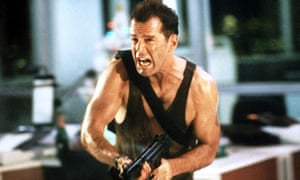
Peter Bradshaw on action movies
In some ways, it should be the quintessential cinema genre. After all, what does the director shout at the beginning of a take? Action – at times a euphemism for violence and machismo – evolved into a recognisable genre in the 80s. Gunplay and athleticism resurfaced in a sweatier and more explicitly violent form, with movies such as Sylvester Stallone's First Blood. The hardware was all-important, and the metallic sheen of the guns was something to be savoured alongside the musculature of the heroes. The genre spawned the action hero. These were not pretty-boys there to melt female hearts: they were there to get a roar of approval from the guys. The ultimate action star, Arnold Schwarzenegger, became governor of California. Who knows if there will be a constitutional change to get an action star into the White House?
10. The Last of the Mohicans

Ferocious hand-to-hand combat, stunning scenery and Daniel Day-Lewis tearing through the forest, bare-chested like a force of nature. Eighteenth-century action drama might have looked like an outdoorsy departure from cop thrillers for Michael Mann, but he turned up the heat of James Fenimore Cooper's frontier fable: the story of Hawkeye (Day-Lewis), adopted by Mohicans after his parents were killed.
It is 1757, and the British and French are waging war for the colony, with native American tribes making allegiances on either side. Allied to no one, Hawkeye is the first American hero in the western's mould of manliness. There is a woman involved, of course, and a gutsy one at that: Cora (Madeleine Stowe), who shows her mettle early on when she slips a gun into her pocket. Hawkeye comes to her rescue when she is ambushed en route to join her father, a British officer – Mann delivering an epic helping of romance with the action.
Day-Lewis had won an Oscar a couple of years earlier for My Left Foot and his immersion method acting was still something of a novelty in 1992. To prepare for the role of Hawkeye he learned to live hand-to-mouth in the forest, skinning animals and building canoes. Matching him sinew for sinew is Wes Studi as the bloodcurdlingly vengeful villain Magua, who vows to rip the heart out of an old adversary. He meets his match in Cora's teenage sister in one of the film's most extraordinary scenes. Gripping to its clifftop showdown. Cath Clarke
9. Goldfinger
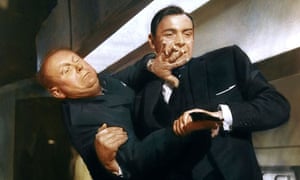
This was the point in Ian Fleming's series of novels at which many critics thought he might have stepped over the line into self-parody. Among the movies, this is where the series – the franchise, by now – stepped out of the shadow of Sax Rohmer and Eric Ambler and really got under way. Fleming purists be damned: the gadgets, the gold-painted girls and the cartoonish henchmen (paging Oddjob!), along with the go-go girls 'n' gunplay credit sequence and John Barry's music, were what the series was all about by this time, and every subsequent Bond movie used Goldfinger as its template.
Where to start? The card game that opens the movie or the epic golf match in the middle? The gold-obsessed villain or the hulking Korean hardman? The near-castration with the laser beam or the gangster compacted in his Continental? And who could forget sexually ambiguous Pussy Galore, as essayed by husky-voiced, karate-hopping 40-year-old bombshell Honor Blackman? It's a compendium of everything one loves about 007 – and with Connery at his apogee. Along with the Beatles, the most significant and most remunerative British cultural export of the 60s. John Patterson
8. The Adventures of Robin Hood
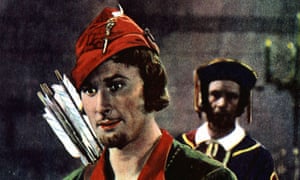
What a strange and different movie this might have been had it starred Jimmy Cagney, as was originally planned. Happily his suave and seductive replacement, Errol Flynn, made the part his own, and the movie still stands as one of the most energetic and likable swashbucklers of Hollywood's prewar heyday. Fine-tuned for endless thrills and maximum entertainment value, Robin Hood shows the Warner Brothers house style at its best, with every part, small or large, perfectly cast with one or another of the studio's contract players: Alan Hale as a rambunctious Little John, Eugene Pallette as a gravel-voiced Friar Tuck, Basil Rathbone as Sir Guy of Gisbourne and the breathily virginal Oliva de Havilland as a winsome Maid Marian.
Plot-wise, it's Walter Scott (he who first split arrow with arrow) meets the gruff, left-inclined Warner Brothers writing unit, with Hood's "rob-the-rich-to-feed-the-poor" ethic striking a particularly popular-frontish chord in the late stages of the Great Depression, from which this movie was surely a delightful and transporting 102 minutes of relief and escapism – and all that in sparkling Technicolor! JP
7. Die Hard
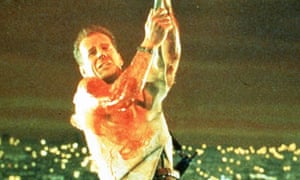
Arnold Schwarzenegger may be beefier and Sylvester Stallone may direct his own films but, admit it, you love Bruce Willis the most. Actually, that's not strictly true. You don't love Bruce Willis at all. Bruce Willis made Hudson Hawk and Perfect Stranger. Bruce Willis named one of his own children Rumer. Bruce Willisfancies himself as a pop star. No, it's John McClane who you love. And even that's not strictly true. You don't love the homicidal lunatic from Die Hard 2, or the ancient bald-headed superman from Die Hard 4. You love John McClane from the first Die Hard. The barefoot, vest-wearing John McClane, trapped in a skyscraper full of terrorists at Christmas and surviving purely on instinct alone. Of course you love him. Why wouldn't you?
But there's more to Die Hard than just one character. It's a brilliant, suspenseful, witty, drumskin-tight action film littered with truly iconic moments, and it arguably hasn't been bettered in almost a quarter of a century. Alan Rickman soars as the urbane terrorist Hans Gruber, Bonnie Bedelia is convincingly ballsy as Willis's wife and Hart Bochner damn near steals the show as the loudmouth cokehead who almost gets everyone killed. You've probably never met anybody who doesn't like Die Hard, and there's a very good reason for that. It's dangerously close to perfect. Stuart Heritage
6. Bullitt
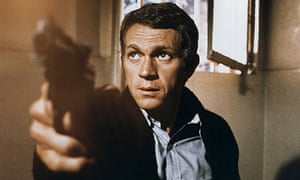
Sure, there's a fantastic car chase in it – one of the first, still one of the best – but Peter Yates's first American movie is so much more than a duel on wheels. First off, it belongs in the esteemed company of Greed, Vertigo, The Lineup, Dirty Harry and Zodiac as one of the finest movies set and shot in San Francisco, that most beguilingly cinematic of American cities. Secondly, it offers the distilled essence of Steve McQueen as an actor and icon at the pinnacle of his career. Exercising his usual restraint, the actor (working as his own producer) pruned every redundant word from his own role, making Bullitt perhaps the most taciturn hero of the 60s – McQueen knew that the less he said, the more intently the audience focused on him.
He is the near-silent centre of a very busy, compelling and violent crime drama. Blessed with the fresh eyes of newly landed Englishman Yates (and genius cameraman William Fraker), the movie makes San Francisco fresh and alive, but also completely remakes and modernises the bleak, sleazy gangster demi-monde in which Bullitt does his hunting – moviegoers wouldn't see those same pointy, elongated shirt collars on gangsters again until Goodfellas. And the moment when one gangster gets blown away with a pump-action shotgun, lifting him off his feet and halfway across the room, was a key turn in the development of on-screen violence before Sam Peckinpah rewrote the rules a year later in The Wild Bunch.
The final pursuit across the runways of San Francisco airport inspired a similar white-knuckle sequence in Michael Mann's Heat, which is to phantasmagoric, nocturnal LA what Bullitt was to San Francisco. Oh, and there's this great car chase … JP
5. Raiders of the Lost Ark

What's the first thing that comes to mind when you think of Raiders of the Lost Ark? The hat? The theme tune? The weird Chinese boy whose presence hasn't really dated very well? No, not that last one, he was in the next film. But the point is this: Raiders of the Lost Ark, the film that introduced Indiana Jones to a grateful planet, was born a fully formed classic. The film is almost perfect, right from its gloriously protracted opening all the way to its ironic, almost downbeat ending.
Dreamed up in the all too brief post-Empire Strikes Back/pre-Howard the Duck golden era of George Lucas's career, Indiana Jones was envisioned as a freewheeling homage to pulpy wartime serials like The Lone Ranger and Hawk of the Wilderness. The casting of Harrison Ford was nothing short of a masterstroke – allowing him to play a more conventional hero than he'd been able to in Star Wars, but still leaving plenty of room for his world-weary cynicism.
Raiders of the Lost Ark is a film from a different era; a Boys-Own era when you were still allowed to have cartoonish Nazis for villains and the phrase "produced by George Lucas" didn't inspire sleepless nights and palpitations. There's romance, there's adventure, there are world-class death scenes and there's definitely no sign of Shia LaBeouf getting chased about by some big ants in the jungle. SH
4. Crouching Tiger, Hidden Dragon
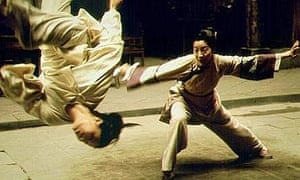
In 2000, a knockout blow for the venerable martial arts movie was visited upon unsuspecting western audiences by Crouching Tiger, Hidden Dragon, Ang Lee's exhilarating addition to the genre. Hardened critics at Cannes greeted fight scenes with excited applause. People who'd have never dreamed of watching martial arts found themselves debating the finer points of wuxia, the fighting style that allows its practitioners to defy gravity and soar above rooftops.
Shot with Chinese actors speaking Mandarin, but co-scripted by US writer James Schamus, Crouching Tiger was received indifferently in Asia but proved immensely popular in the west, winning four Oscars and becoming the highest-grossing foreign-language film in American history. No wonder: you could lose the subtitles and still be transfixed by the film's visual delights. The scenery, taking in Qing-dynasty Beijing, the ghost city of Xinjiang and other extraordinary Chinese locations, is magnificent. The fight scenes are choreographed with exquisite grace by Yuen Woo-ping, whose work on The Matrix had wowed audiences the previous year.
The most famous scene has famous warrior Li Mu Bai (Chow Yun-fat) and upstart Jen Yu (Zhang Ziyi) battling with swords at the tops of tall, swaying bamboo trees. No less thrilling is the rooftop scene in Beijing, or Jen Yu's show-off battle at a traveller's inn. With fight scenes like that, the plot doesn't matter, surely? What's most pleasantly surprising about Crouching Tiger is how emotionally involved in the characters' stories you get. Li Mu Bai and Yu Shu Lien (Michelle Yeoh) are the famous warriors who fear only declaring their love for each other. Jen Yu is the impetuous governor's daughter who engages in a secret affair with a desert bandit (Chang Chen) and fancies herself a warrior. In keeping with genre traditions, the plot is intricate, requiring a great deal of exposition – including daringly extensive flashbacks which reveal Jen Yu's adventures in the desert – but Lee handles it all with consummate skill. Killian Fox
3. The Wages of Fear
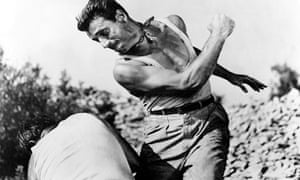
When Henri-Georges Clouzot took on a genre, it generally led to a classic: so Les Diaboliques is one of the most frightening pictures ever put on screen; The Mystery of Picasso is among the most outstanding films exploring the work of an artist; and The Wages of Fear has no superior in the field of action-suspense. Set in an unnamed south American country, the action starts in a small town with an airfield where we are introduced to four shady characters anxious to get out, but minus the money for a plane ticket. A very venal oil company offers them $2,000 each to drive trucks loaded with nitroglycerine over rough mountain roads to an oilfield that is on fire. The roads are awful. The hazards are unlimited. And the nitro, sweating in the heat, itches to explode long before it gets to the oilfield.
The way Clouzot films this process (in a movie of over two and a half hours) is a model of grinding, unrelieved suspense. The film was shot in black and white, not in south America but in the south of France. And it is now well over 50 years old. Yet the inspired calculation of action and agonised human reaction is irresistible and inescapable. It is a film that leaves the audience shattered and exhausted.
All of which is enhanced by the feeling, common to most of Clouzot's pictures, that he rather despised people and knew that sooner or later their worst traits would come through. Of course, the trick to that is that these tough guys become all the more heroic because they are not sentimentalised. So the picture hangs on four grim faces – Yves Montand, Folco Lulli, Charles Vanel and Peter van Eyck. We depend on them. Yet we know the remorseless destiny of nitro. We are there with them, and, as in any intense experience of combat or action, they become brothers and comrades. David Thomson
2. Deliverance
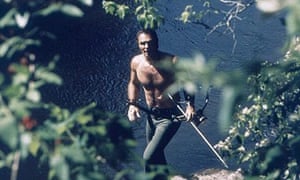
Warner Brothers originally fancied Roman Polanski for director. The novel's famously macho author, James Dickey, wanted Sam Peckinpah. And originally under consideration for the leads (later taken by Burt Reynolds and Jon Voight) were Lee Marvin and Marlon Brando. But Deliverance as it was finally made is so indelible, even after 40 years, and its impact has been so lasting, that even those mouthwatering possibilities are obliterated by what John Boorman finally wrought.
Depending on your viewpoint, Deliverance is the first eco-thriller (Dickey's novel was published in 1970, the year of the first Earth Day celebration, and remained a bestseller throughout the 70s), or a meditation on American machismo in its suburban, postwar variant. The thoughtful, sedentary adman Ed (Voight) must find it in himself to embrace the hunter-warrior ethic of his tougher friend Lewis (Reynolds) when the latter is crippled by his injuries, and Ed both loves and hates what he becomes – which is to say, more of a man than Lewis, but perhaps less human.
If you're from rural America, however, particularly from Appalachia, chances are you still hate Deliverance for the powerfully negative effect it has had (and still has) on outsiders' perceptions of this embattled region, presenting it as all hookworm and incest, buckteeth and bluegrass. "Squeal like a piggy, boy!" is a phrase that can still get you beaten up south of the Mason-Dixon line. And, being an eco-thriller, this is one of the greenest movies ever made – green always looked good on Boorman, especially in his riotously verdant Excalibur and The Emerald Forest. Working with a narrow palette here, he excludes most non-natural tones, making the blood that finally flows all the more vividly scarlet and shocking.
For all the furious excitement of its river-rafting sequences, and the harshness and humiliation of its explosive central rape scene, Deliverance is an elegiac movie, mourning the rural mountain culture soon to be inundated by a new hydro-electric dam. A people is displaced, churches are uprooted and coffins disinterred, so that Atlanta, home of our four suburbanites, can have power and light. Karma demands payment for that, and takes it, brutally. JP
1. North by Northwest

Roger O Thornhill (his monogram is ROT) is unlucky and terribly accident prone – he is the sort of person who gets dead men collapsing in his arms, and who can't find himself at a lonely bus stop, near a farmer's field, without having a crop-dusting aircraft turn on him. On the other hand, he is lucky: when forced to jump on a train to escape, the beautiful and utterly available Eve Kendall (Eva Marie Saint) is willing to let him into her sleeping compartment. Above all, he has the good fortune to be Cary Grant, who never quite loses his cool even when dangling from George Washington's stone lip on the Mount Rushmore memorial. All he has to do is just keep heading north by northwest.
As written by Ernest Lehman and directed by Alfred Hitchcock, this is many things – it's a mystery, it's suspense, it's a love story, it's even the study of a frivolous man growing up at last, and it's an outrageous comedy in which the action mounts with a serene, runaway logic that Hitchcock never gives us time to question. On the other hand, it's the vindication of a great principle: if the irrational action moves fast enough, no audience will ever have breath to question it. No one ever really recalls the inner drive of the plot, but we all know Mount Rushmore and the cornfield by heart.
It has been fashionable in recent years to admire Hitchcock for the gloomy (and equally far-fetched) Vertigo, which was made only a couple of years before North by Northwest. But I'm not sure this comedy thriller isn't the purer and more satisfying film, and the one more totally given over to cinematic action. Or to one damn thing leading to another.
In that sense, the motif of the chase is what has always linked suspense and farce – we are supposed to take the first more seriously than the second, but not lose sight of the momentum and the madness in both. North By Northwest never quite sinks to slapstick, but it is a sophisticated rollercoaster. And once we've stepped on the machine there's no getting off. Yes, there's a villain, but when I remind you that it's the adorable, drawling James Mason, you'll know that this is quite simply a terrific game of tennis with grenades for balls. DT
SOURCE: http://www.theguardian.com/film/filmblog/2013/oct/10/top-10-action-movies
No comments:
Post a Comment